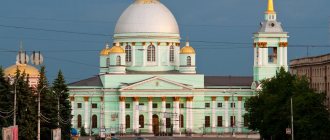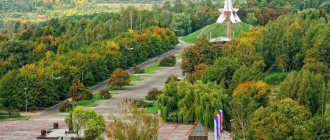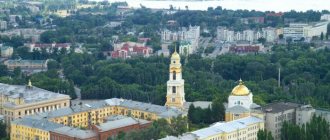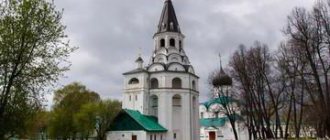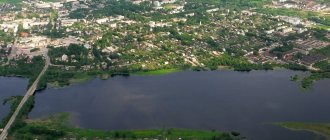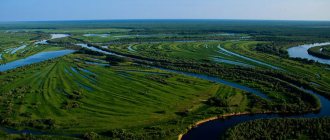Onega. Small town in Belomorye
In the photo: Onega street.
August 2021. Onega is a city of regional significance in the north-west of the Arkhangelsk region, the administrative center of the Onega region. The settlement is located at the mouth of the river of the same name, where it reaches a width of about one kilometer. The city is located approximately seven kilometers from the Onega Bay of the White Sea and 260 kilometers from the regional center - Arkhangelsk.
The city owes its name to the river on which it actually stands; the etymology of the name of the river is a question that probably awaits its researcher for subsequent study. It is undeniable that the name “Onega” in the context of a river and, accordingly, a settlement is not directly related to Lake Onega (by the way, the river and lake are also not related to each other geographically, they even belong to the basins of different oceans - the Northern Arctic and Atlantic).
Onega River. August 2021.
Before starting the story about Onega itself, it is necessary to give a little historical information about the processes that influenced the formation of the settlement. In the Middle Ages, the colonization of the territory of the present Arkhangelsk region took place in the form of two powerful waves. The center from which one of them followed was Veliky Novgorod. The second stream of settlers followed to the territory of the modern Russian North from the Rostov-Suzdal and Vladimir principalities (in the specialized literature this wave of colonization is also called the “Upper Volga” or “Nizovskaya”). The Novgorodians were the first to colonize the lands adjacent to them from the North, trying to get fur there and, which was strategically important, salt, which acted as a preservative for perishable food products. Representatives of the lower wave were often refugees who sought to hide in the forests of the North from the predatory attacks of steppe nomads. Novgorodians mastered the northern borders of the current Arkhangelsk region, representatives of the second wave - the southern ones. The difference in the traditional material culture of life support of two historical and cultural regions that arose as a result of different waves of colonization of the Russian North is very noticeable.
Onega, of course, is a typical product of the Novgorod wave of colonization of the Russian north, and it is with the economic activities of the ancient Novgorodians (and their descendants - a specific group of the old-time population of the Russian North - the Pomors) that its appearance must be associated.
The year of foundation of the city is considered to be 1137, since it was during this year that Onega was first mentioned in written sources, namely in the Novogorod Charter of Svyatoslav Olegovich, under the name “pogost on the sea.” However, this source must be treated with a considerable degree of caution, since it cannot be ruled out that under this ancient name, for example, the current village of Nenoksa is hidden.
However, subsequent references to the settlement are already quite specific. Probably, a native of Onega was the domestic pioneer cartographer Ivan Amosov, who collaborated with the diplomat and traveler Grigory Istoma.
It is known that in the 16th-17th centuries Onega (then known as “Ust-Onega”) was part of such a territorial-administrative union as the Turchasovsky camp as part of the Kargopol district.
Today Turchasovo, the former “capital” of the Turchasovo camp, is a small village with a beautiful wooden church. Photo from the Internet.
In the 16th century, Onega, as well as many settlements in the Russian North, was devastated by Polish-Lithuanian troops during the fighting during the Time of Troubles.
In 1780, Onega, by order of Empress Catherine II, acquired the status of a city and soon the settlement acquired its own coat of arms.
Also at the same time, a master plan for the development of the city was adopted.
In 1829, the oceanographer Mikhail Frantsevich Reineke (1801 – 1859) visited Onega; the city appeared before him in the following form:
“The city construction plan remained unfulfilled. By 1800, the following buildings were built: a cathedral and one state house - the treasury. Instead of regular blocks of buildings, not only old but also new buildings are scattered haphazardly and mostly near the river bank over a distance of two miles. Of the earthen fortifications, only three batteries were built above the city, and they collapsed.”
In general, the traditional history of Onega is inextricably linked with two types of activity: logging and marine research. The maritime history of a modest city can really impress: for example, Alexander Kuchin, the only non-Norwegian member of the famous Amundsen expedition to the South Pole (on the research vessel Fram), was a native of Onega.
Alexander Kuchin (1888 - 1913), archival photograph.
In Onega in 1916, the hunting vessel “Perseus” was manufactured, which subsequently, being refitted in Arkhangelsk, became the first research vessel, the “flagship” of Soviet polar research for many years.
Memorial sign in honor of "Perseus". Onega, August 2018.
In addition to marine researchers, as mentioned above, Onega is famous for its ship forests: a great variety of mast pines and larches grow in the vicinity of the city.
It is known that in 1752, the outstanding nobleman of Catherine’s times, Pyotr Ivanovich Shuvalov, had the right to monopolize felling and subsequent commercial sale of the Onega forest.
During the Civil War and the fight against the invaders, the city became a site of clashes between various opposing forces, and passed from the hands of the British occupation authorities to the Bolsheviks and back several times. A memorial stele dedicated to those events was erected in the city.
In addition, in the Onega region in pre-revolutionary times, an interesting group of dialects took shape, which were studied by O.A. Podvysotsky.
Onega modern
Today, the picture of the dynamic development of the population of the city of Onega fully falls within the general trends characteristic of many settlements in the Russian northwestern Arctic zone, namely, there is a pronounced outflow of population. If in 1989 there were 26 thousand people living in the city, today the population of Onega is about 18 thousand.
The main residential buildings in the city are low-rise wooden houses with gable roofs, heated by stoves.
Wooden pavement in Onega.
August 2021. Residents of such houses collect water from street pumps, and there is no centralized sewage system. In general, such buildings are quite monotonous, but from time to time you come across ancient houses with window frames richly decorated with carvings.
The approaches to the city, especially those along the river and sea, are abundantly built up with small dachas, most of which are owned by Arkhangelsk residents.
The pearl of old Onega is the ancient Holy Trinity Cathedral, founded in 1796. This is a capital two-story stone structure, erected on the site of an older, wooden church built in 1597, which burned down in the middle of the 18th century.
Holy Trinity Cathedral in Onega, August 2021.
The history of the ancient temple knew its ups and downs: it burned in pre-revolutionary times, but was rebuilt every time. Years of neglect and misuse during the existence of the Soviet Union had a significant impact on the construction. Over the years, the building of the Holy Trinity Cathedral housed a warehouse for a local history museum, a city party committee, apartments for Soviet officers, a station for young technicians and even a stable. In 2002, the cathedral building was again used for its original purpose: the temple was restored and today services are held there. In addition, a spiritual choir consisting of city residents performs in the cathedral, and there is a Sunday school.
Church of Lazarus the Righteous in Onega. It needs restoration and, although it is located not far from the city center, it is closed on all sides by pine trees. August 2021.
The greatest interest in Onega is the Verkhovye district, where the largest amount of historical buildings has been preserved.
And if ancient Onega still has something to brag about to the world, then this, unfortunately, cannot be said about Soviet Onega, since there is little in it that betrays the antiquity of the strange Pomeranian settlement.
The compact center of the Soviet city is built up with a small percentage of brick and reinforced concrete buildings. In the very heart of the village there is the Yubileiny Hotel and the city administration building.
During the Soviet years, there was a cinema “Cosmos” in the city; nowadays, a clothing market is located in this building. In addition, if we talk about large chain stores, it should be noted that over the past two years two supermarkets under the Pyaterochka brand have opened in the city.
Sometimes in Onega you get the impression that the city is being encroached on from all sides by a forest. August 2021.
There is a railway station on the outskirts of the city, but at the moment the railway connection with the city itself has been stopped, so the only function it performs is the possibility of selling tickets. If residents of Onega need to get on a train, they buy a ticket from the nearest regularly operating station - Obozerskaya.
Previously, electric trains and local trains came to Onega. A train with general carriages ran along the Onega – Arkhangelsk route; the train’s travel time was one night. Now the most popular and in demand method of transport between Onega and the regional center is minibuses.
The city has the only educational institution where everyone can receive secondary specialized education - the Onega Industrial College. The list of specialties offered at the institution is quite typical for standard vocational schools: cooks, auto mechanics, welders, salesmen and tractor drivers.
The main type of employment of local residents is logging and subsequent wood processing; in addition, a considerable part of Onezhan residents work in the nearby special regime correctional colony - IK-16. In the past, there was a meat processing plant and a hydrolysis plant in the city, but now these institutions are no longer functioning. However, Onega has its own dairy products, and, for example, Onega residents managed to establish the production of fairly high-quality yogurt.
A neat Onega courtyard. August 2021.
Recently, the maternity ward in the Onega hospital was liquidated, and now all women giving birth are sent to Arkhangelsk for maintenance. For some expectant mothers from low-income segments of the population, such trips seem prohibitively expensive, so some of them deliberately wait for the start of labor in an outpatient setting so that they can be transported to Arkhangelsk free of charge by medical aviation. We will not argue that such situations can be called a systematic phenomenon, but similar precedents, nevertheless, took place no more than last year.
“The outflow of residents from the city is quite large,” says Svetlana Kameneva, a resident of the Onega district. – Especially, of course, among young people. Those guys who graduate from high school in Onega tend to leave the city to study in Arkhangelsk, for example, and almost none of them return to their permanent place of residence. In percentage terms, there are a lot of old people in the city who are simply living out their lives. The town has big problems with leisure activities, so many people reach for the bottle. Of course, this problem was especially clearly expressed in the 90s, when the local population massively consumed such a drink as “Russian North”, which, formally considered a technical liquid with a high content of potable alcohol, carried away more than a dozen Onezhan residents to the next world.
In fact, the Onega region and the city itself in particular seem to be quite an attractive destination for tourism, due to its proximity to the sea, picturesque landscape and ancient wooden architecture. Everything is complicated by the fact that the appropriate infrastructure has not been created in the area. For example, in a significant part of the Onega region there is still no mobile phone coverage, and the roads are impassable. Existing progress, such as the project to build a water park in Onega, cannot decisively break the established state of affairs.
Author:
P.V. Kamenev, postgraduate graduate of the Murmansk Arctic State University.
Photos by T.N. Shabaeva (unless otherwise indicated).
List of used literature:
1. Bernshtam, T. A.. Pomors: Group formation and economic system. / T.A. Bernshtam - Leningrad. Science, Leningrad branch. 1978.. – 176 p.
2. Borovoy, V. Ya. Where Onega Flows. / V.Ya. Borovoy - Onega, 1994. - 70 p.
3. Vasev, V. N. Poonezhie: past and present. / V.N. Vasev - Velsk, 2008. - 440 p.
4. Podvysotsky A.O. Dictionary of the regional Arkhangelsk dialect in its everyday and ethnographic application / A.O. Podvysotsky. - M.: OGI, 2009. - P. 576.
5. Simakova L. Alexander Kuchin. Russian by Amundsen / L. Simakova, M. 2015. - 320 p.
Climate
- The climate is temperate, slightly continental with frequent cyclone incursions and high rainfall; characterized by moderately warm summers (from early May to early October) and moderately mild (for northern latitudes) winters. This is due to its coastal location and the influence of the Atlantic.
- A stable snow cover forms in mid-November and persists until the third ten days of April. The duration of its occurrence in Onega is 150-170 days. The average height of snow cover is from 20 cm in December to 40-45 cm in mid-winter, reaching its maximum value - 50-60 cm - in March.
- Average annual air temperature: +2.2 °C
- Relative humidity: 79%
- Average wind speed: 2.4 m/s
| Climate of Onega | |||||||||||||
| Index | Jan. | Feb. | March | Apr. | May | June | July | Aug. | Sep. | Oct. | Nov. | Dec. | Year |
| Absolute maximum | 6,1 | 5,1 | 13,4 | 25,9 | 32,1 | 32,9 | 35,8 | 34,4 | 27,4 | 19,8 | 11,1 | 7,7 | 35,8 |
| Average maximum, °C | −8,2 | −7 | −0,9 | 5,7 | 12,7 | 18,9 | 22,0 | 18,6 | 12,8 | 5,5 | −1,7 | −5,6 | 6,1 |
| Average temperature, °C | −11,4 | −10,5 | −4,8 | 1,2 | 7,4 | 13,6 | 16,9 | 13,9 | 9,0 | 3,1 | −4 | −8,5 | 2,2 |
| Average minimum, °C | −15 | −13,9 | −8,5 | −2,7 | 3,2 | 8,8 | 12,4 | 9,9 | 5,9 | 0,9 | −6,4 | −11,9 | −1,4 |
| Absolute minimum, °C | −42,1 | −42,5 | −38,5 | −26 | −14,6 | −3,4 | −0,4 | −3 | −4,9 | −19,3 | −31,5 | −41,2 | −42,5 |
| Precipitation rate | 42 | 31 | 30 | 29 | 43 | 59 | 70 | 75 | 69 | 68 | 55 | 46 | 617 |
| Source: [pogoda.ru.net/climate/22641.htm Weather and climate] Norm for the period 1981-2010. | |||||||||||||
| Water temperature (data for 1977-2006) | |||||||||||||
| Index | Jan | Feb | Mar | Apr | May | Jun | Jul | Aug | Sep | Oct | But I | Dec | Year |
| Absolute maximum | 0,0 | 0,0 | 0,0 | 5,4 | 17,6 | 25,5 | 26,5 | 26,7 | 18,2 | 12,4 | 4,2 | 1,3 | 26,5 |
| Average temperature, °C | 0,0 | 0,0 | 0,0 | 0,1 | 6,4 | 15,4 | 19,2 | 16,6 | 10,6 | 4,0 | 0,4 | 0,0 | 4,8 |
| Absolute minimum, °C | 0,0 | 0,0 | 0,0 | 0,0 | 0,0 | 6,9 | 12,1 | 8,9 | 3,5 | 0,0 | 0,0 | 0,0 | 0,0 |
| Source: [data.oceaninfo.info/atlas/Beloe/2_watertemp_station_87035_1.html ESIMO] | |||||||||||||
Economy
Onega, together with the Onega region, is equated to the regions of the Far North, and is also part of the Arctic zone of the Russian Federation[23].
Industry
The basis of the city's economy is the timber industry. The city-forming enterprise is the sawmill and woodworking plant (OJSC Onega LDK); the city is also home to the production and logging association Onegales, which carries out logging in several districts of the Arkhangelsk region.
Previously, the city had a hydrolysis plant that produced ethyl alcohol, feed yeast, and furfural from sawmill waste. In 2016, on the basis of a former hydrolysis plant, a plant for the production of biofuel (pellets) from forest waste was launched.
Transport
Sea port, railway station, Onega airport.
Onega seaport was opened in 1781. Navigation from May to early November, attempts were made at year-round navigation using icebreakers. The port is located at the mouth of the river. Onegi can accommodate vessels up to 115 meters in length, with a draft of up to 4.5 meters. Due to the shallowness of the Onega Bay, approach channels and fairways with a length of 12 miles are used. The main cargo transported is timber (lumber, round timber, wood chips).
The city is connected by a highway built in the 2000s with Severodvinsk, and there is a bus service with Severodvinsk and Arkhangelsk. Bus routes also connect Onega with a number of settlements in the region. There are 4 intracity bus routes. During navigation, a ferry runs between the main and left bank parts of the city; in winter, an ice road is created.
13 km east of the city of Onega there is an abandoned military airfield called Vatega (the length of the runway is about 3 km).
Links
Baltic Sea Vyborg • Vysotsk • Kaliningrad • St. Petersburg (Bolshoi Port and Passenger Port) • Primorsk • Ust-Luga Barents Sea Varandey • Murmansk • Naryan-Mar White Sea Arkhangelsk • Belomorsk • Vitino • Kandalaksha • Kem • Mezen • Onega • Severodvinsk Bering Sea Anadyr • Beringovsky • Provideniya • Egvekinot East Siberian Sea Pevek • Chersky Kara Sea Amderma • Dixon • Dudinka • Igarka • Sabetta Caspian Sea¹ Astrakhan • Makhachkala • Olya Laptev Sea Tiksi • Khatanga Sea of Okhotsk Korsakov • Magadan • Moskalvo • Cape Lazarev • Nikolaevsk-on-Amur • Okhotsk • Poronaysk • Prigorodnoye Pacific coast of Kamchatka and Kuril Islands Petropavlovsk-Kamchatsky Black Sea Anapa • Gelendzhik • Evpatoria4 • Kerch (commercial • fishing • Kamysh-Burun • Port “Crimea”)4 • Novorossiysk • Sevastopol4 • Sochi (commercial and passenger • cargo) • Taman² • Tuapse • Feodosiya4 • Chernomorsk4 • Yalta4 Chukchi Sea Cape Schmidt ³ Sea of Japan Aleksandrovsk-Sakhalinsky • Boshnyakovo • Vanino • Vladivostok • Vostochny • De-Kastri • Danube • Zarubino • Nakhodka • Nevelsk • Olga • Plastun • Posyet • Preobrazhenie • Rudnaya Pristan • Svetlaya • Slavyanka • Sovetskaya Gavan • Uglegorsk • Kholmsk • Shakhtersk ¹ Caspian Sea is actually a lake.
² The port of Taman
is under construction, but is already open for traffic.
³ The port of Cape Shmidt
has been part of the port of Pevek since 2006. 4 Located on the territory that is the subject of a territorial dispute between Russia and Ukraine.
Notable residents
- Vsevolod Vyacheslavovich Valyusinsky is a Soviet science fiction writer.
- Boris Nikolaevich Grakov - Doctor of Historical Sciences, professor, Soviet archaeologist.
- Gennady Borisovich Deryagin - Doctor of Medical Sciences, professor, forensic physician, criminal sexologist.
- Valentin Ippolitovich Mankevich - Hero of the Soviet Union.
- Gennady Ivanovich Katarin - Hero of the Soviet Union.
- Nikita Ivanovich Kozlov - Hero of the Soviet Union.
- Alexander Stepanovich Kuchin - Russian polar explorer, navigator, hydrographer, participant in Amundsen's expedition to the South Pole, captain of the schooner "Hercules" of the deceased Rusanov expedition.
- Alexey Nikolaevich Larionov - functionary of the CPSU, Hero of Socialist Labor.
- Prokopiy Fedorovich Telov - Hero of Socialist Labor.
- Alexander Osipovich Shabalin - rear admiral, twice Hero of the Soviet Union.

